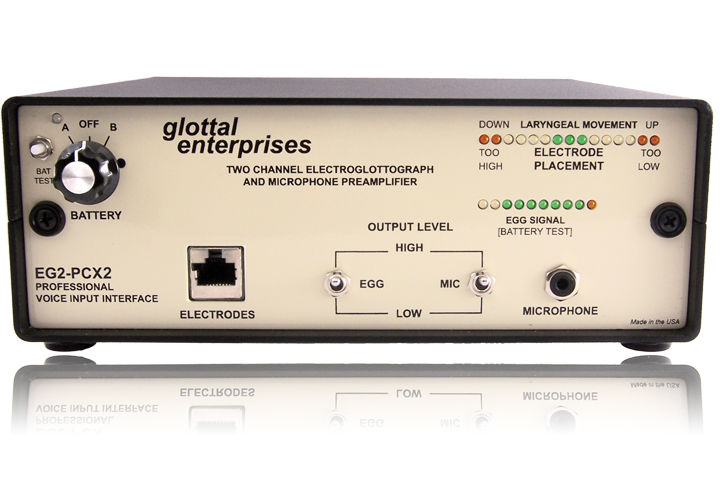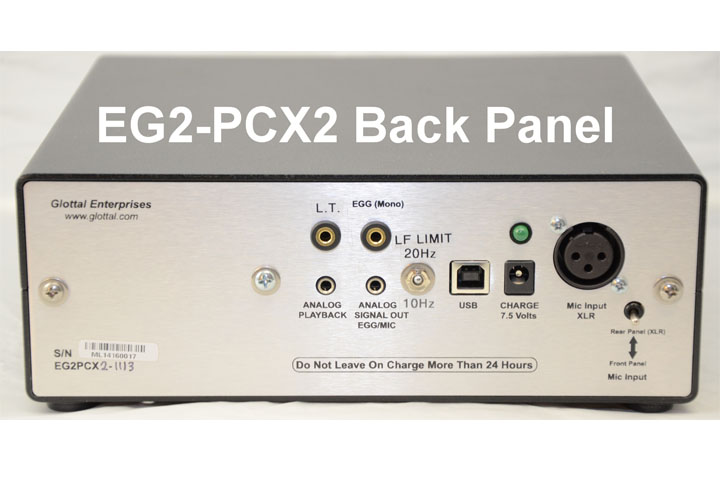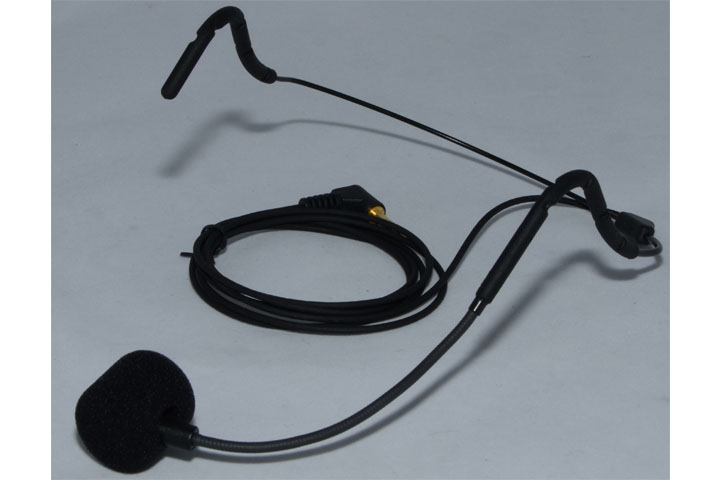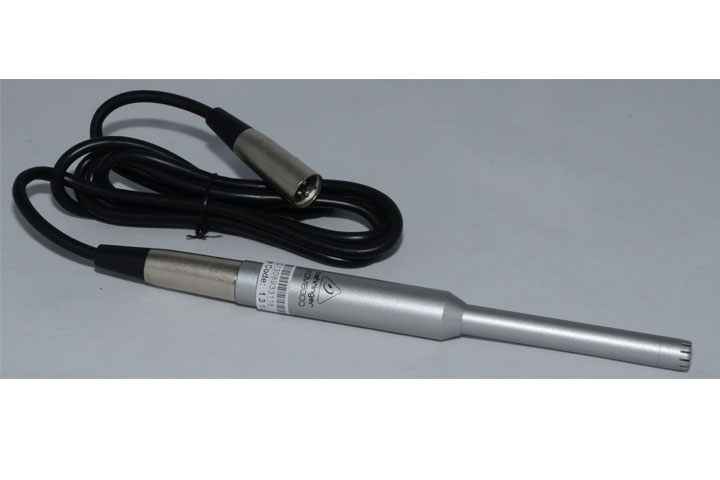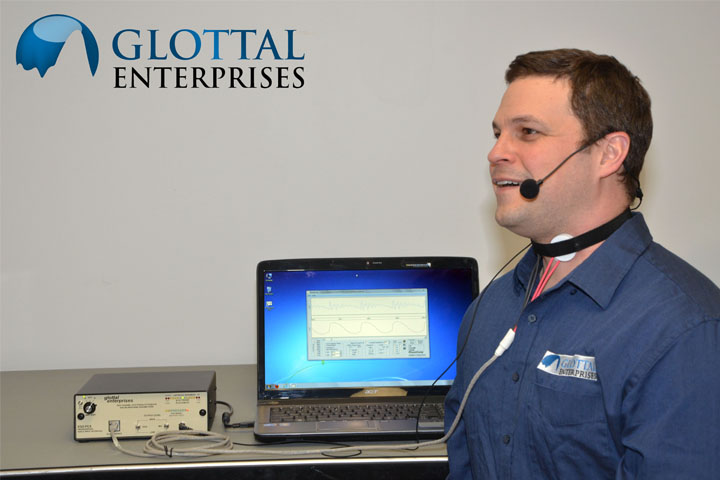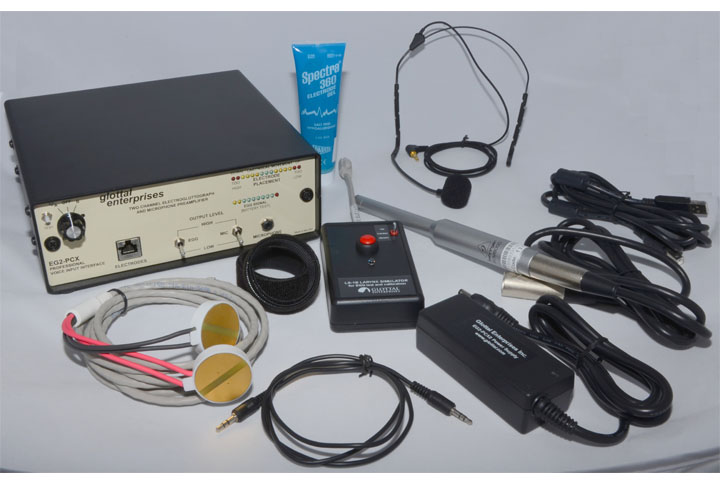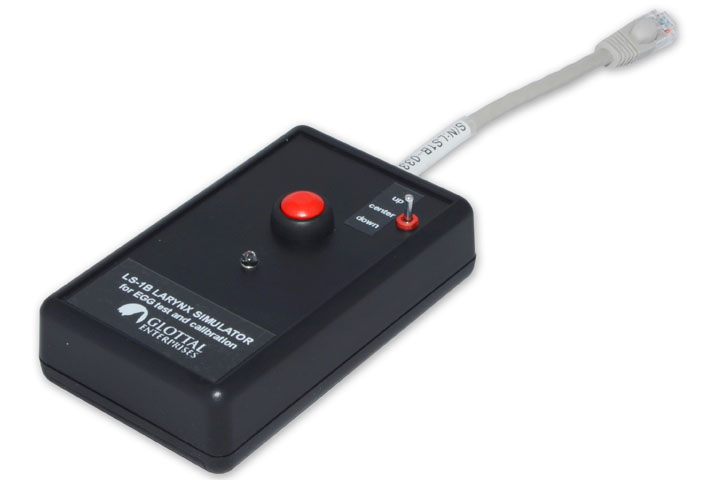
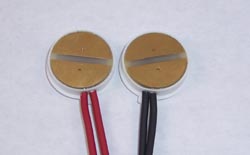
The dual-channel electrodes
for the EG2-PCX2 measure the translaryngeal electrical
resistance at two adjacent locations on the neck. These two
signals are combined at the main EGGelectroglottograph output, or can optionally
be recorded separately.
|
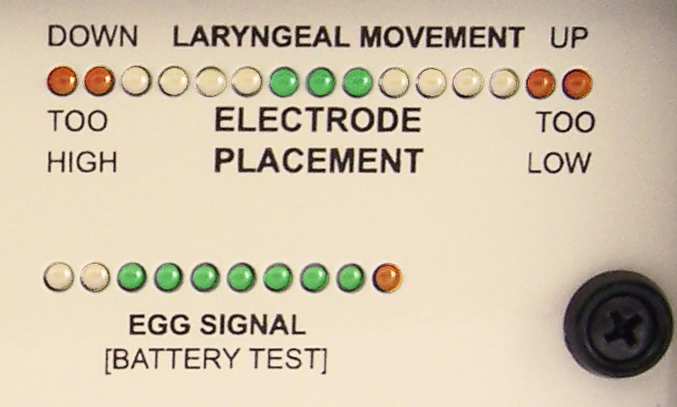 An LED array on the front panel (top array) can be used either to properly position the electrodes or to track the movement of the larynx. |
|
|
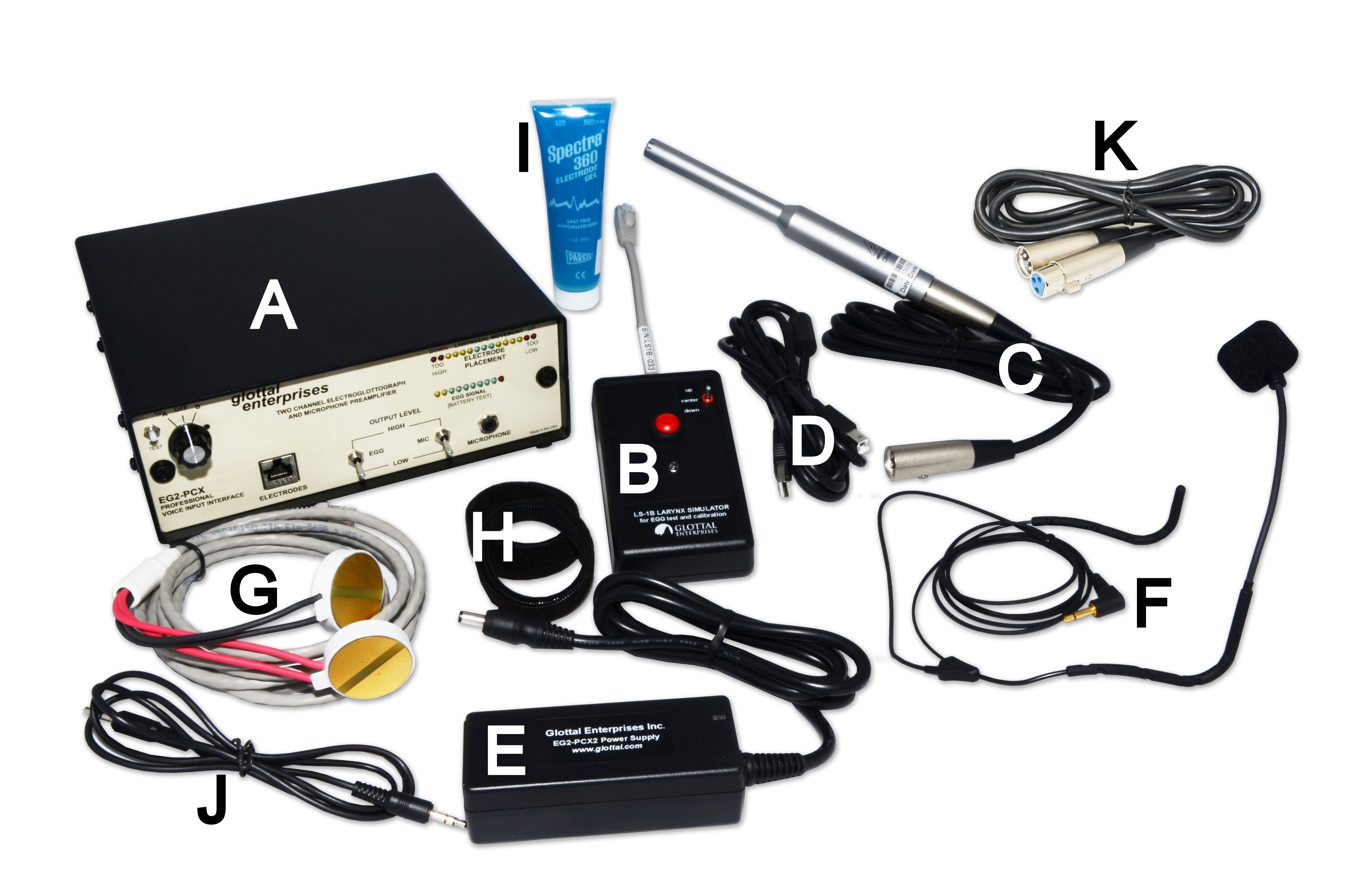
This product is for research and teaching purposes only. It is not a medical device. It is not intended to be used in the diagnosis, cure, treatment, mitigation or prevention of disease and it is not intended to affect the structure or function of the body.
1. How large is the system?
| The electroglottograph electronics weigh about 8 pounds and with accessories will fit comfortably on a desktop. The unit ships in a hard case that can contain it as well as its accessories. |
2. Can I use the EG2-PCX2 with my PC? MAC? iPad? Laptop?
| The software included with the EG2-PCX2 will work on Windows XP/Vista/7, but is not available for iOS (Mac, iPad, etc.) However, though it is not officially supported by Glottal Enterprises, the software has been observed to work on a Macintosh computer when booted to Windows. |
3. Can I power my EG2-PCX2 from my computer's USB connection?
| No. The EG2-PCX2 may only be charged with the provided transformer while not in use. |
4. What kind of files does this system generate?
| Data is natively saved in .wav format making it available to view and manipulate in other software as well. |
5. How is data recorded? How large?
| Data is recorded by the software via USB connection. Typical .wav file sizes are about 1 Megabyte per 6 seconds of record time. |
6. Can I use my own DAQ system?
| Yes. Analog outputs are provided on the EG2-PCX2 unit. The signal is line-level, and can be sampled by 3rd party data acquisition devices. |
7. How do I get replacement or extra parts for my EG2-PCX2?
| Contact us to order parts or to have your Glottal Enterprises equipment serviced. |
8. Can it be used on children and infants?
| Yes. Smaller electrodes are available, and custom electrodes can be built. Contact us to discuss custom builds. |
9. How do I get technical support?
| Contact Glottal Enterprises via e-mail or phone. |
10. How many channels of data can this system record?
| 2 channels of data can be recorded: EGG and microphone audio. |
11. Can I get custom-sized electrodes for my EG2-PCX2?
| Yes. Contact Glottal Enterprises to consult with an engineer. |
12. Do I need electrode gel?
| Electrode gel is not always necessary however it does make a significant difference in ensuring a strong, reliable signal. |
13. Is it possible to sample data from each individual EGG channel?
| Yes. When purchased with optional outputs, the signals from each individual channel are available on BNC jacks. |
14. What kind of filtering is done to the sampled data?
| 40Hz low-frequency limit |
15. What kind of jacks are on the unit for outputting signals?
| 3.5mm |
16. How many hours of continuous use is the EG2-PCX2 capable of?
| At least 8 hours per battery (there are 2 batteries). |
17. How long does it take to charge the EG2-PCX2 once the batteries are depleted?
| About 1 hour to charge from 0% to 90% charge. |
18. How long is the service life of the EG2-PCX2's rechargeable batteries?
| Batteries will last between 5 and 10 years depending on how well the unit was cared-for and stored. |
19. Where can I get replacement batteries once mine are at the end of their service life?
| You may contact Glottal Enterprises and purchase directly from us or from another retailer. |
20. What kind of signal-to-noise ratio can I expect in the EGG signal output?
| The EG2-PCX2 will have 40dB or better signal-to-noise ratio. |
21. What kinds of microphones are compatible with the EG2-PCX2?
| Any dynamic or electret capacitance The XLR microphone jack has 15V available excitation voltage and the 3.5mm mic jack on the front of the unit has 2.2V available excitation voltage. |
22. Do I need an oscilloscope to view the EGG signal?
| No, the EG2-PCX2 was designed to interface with a PC computer to view, record, and manipulate the EGG signal. However, it is still possible to view the EGG signal on an oscilloscope via the included analog outputs. |
23. Do I need to worry about electrical interference from my other lab equipment affecting the EGG signal?
| The EG2-PCX2 is a very sensitive piece of equipment and though it is very well shielded, it is advisable to avoid sources of strong EMI such as large motors, bug zappers, touch-controlled lamps, etc. |
24. Why is electrode placement important?
| To get the strongest, most optimal signal available from a test subject, it is best to have the electrodes centered on the glottis. The two-channel design of the EG2-PCX2 electroglottograph makes it possible to give feedback to the investigator in real-time via an LED array on the front of the EG2-PCX2. You will know when you are properly centered on the glottis regardless of the test subject's anatomy. |
25. What is the difference between the included head-mounted and XLR microphones?
| Both microphones are omnidirectional. The headset microphone is more convenient to use, and the Behringer ECM-8000 microphone is a research-quality microphone with an extremely flat frequency response which is capable of very high fidelity recordings. |
26. Is it possible to manually adjust the gain of the EGG and microphone output signals directly on the EG2-PCX2?
| Yes, the EG2-PCX2 has toggles for high and low gain for both the microphone signal and the EGG signal. They can be adjusted independently of each other. |
27. Is it possible to introduce a test signal to verify the functionality of the EG2-PCX2?
| Yes, the EG2-PCX2 system includes the LS-1 Larynx Simulator which outputs a consistent signal allowing the investigator to confirm that the system is hooked up correctly by eliminating the test subject and electrodes as a possible source of error. |
28. Please describe the optional Fundamental Frequency Trigger Output of the EG2 electroglottograph.
| Using the EGG signal as input, the F0 OUTPUT generates a standard impulse for each glottal cycle, roughly synchronous with the glottal closure instant. It can be useful for teaching purposes, if recorded with any audio recorder and replayed, since it has only pitch information. It can also be useful for speech resynthesis or as the input to a pitch display. However, since there is no complex logic to eliminate the occasional pulse generated by vocal fold motions other than in voicing, a generalized F0 detection software program operating directly on the EGG signal may often yeild a more useful result. |
29. How can EGG signals be displayed, other than by using the Waveview software?
| Any software package that displays stereo audio can display EGG signals, or EGG and audio including free open-source audio editors such as Audacity. However, these programs will not supply the low frequency phase compensation for waveform correction that is in the Glottal Enterprises Waveview program. Our EGG's are now supplied with the program PhaseComp which allows the user to display the EGG signal along with a time Synchronized microphone signal. PhaseComp also corrects one or both signals for low frequency phase distortion and estimates the closed or open quotients. The program VoceVista Signals is also supplied, which allows real-time viewing of these signals. |
30. Why do some subjects show an EGG signal with more noise than others?
| Our EGG units are checked to have a noise level at least a factor of 100 (40 dB) less than a signal equivalent to a neck resistance change of 0.1 %. This level of resistance change is attained, or at least approached, in a typical adult male larynx and neck anatomy. However, with a typically smaller female or child larynx, and even with an adult male subject, if the larynx is deep into the neck muscle, fatty tissue, etc., the noise can be up to a factor of 10 (20 dB) higher. Therefore when recording from persons showing a weaker than average EGG signal, it is important to use electrode jelly, press the electrodes into the neck a little, and use the unit's electrode position meter to optimize the vertical position of the electrodes. Also, the anterior margins of the electrodes should be closely spaced, no more than about a centimeter apart. As for low-frequency noise, the low-frequency limit in a PCX model could be optimally a little higher with the higher F0 of a female or child voice. (The low-frequency limit on the EG-2 model is adjustable, but the PCX value is set to 20 Hz.) An external high pass filter set at about 50 Hz can reduce the low frequency noise for a female or child voice without hurting the waveform significantly. Also, the sensitivity of an EGG can make it susceptible to ambient electromagnetic noise from other electronic devices in the vicinity. This may show up only with subjects yielding a weak EGG signal. If you suspect that there is an external noise source, try recording in another location and/or moving the EGG unit further from the computer. |
31. Why is there an EGG waveform even during voicing with no vocal fold contact?
| An EGG signal generally has two components, one caused by changes in vocal fold contact and one caused by tissue vibration. The second is usually close to sinusoidal in shape, since the mass of the tissues damps out any fast movements. In analyzing the classic, strong, EGG signal, the second or vibrational component is relatively weak and generally ignored. However, if the contact signal is weak, as in breathy voice or falsetto, the vibration component of the EGG signal may dominate. With some practice, one may be able to visually discriminate between the two components. To help illustrate the existence of two components, I have colored the vibration component red in the attached figure. The EGG signal is from a trained singer vocalizing a diminuendo at a pitch of D4 (approximately 290 Hz). The vocal folds are obviously abducting during the period shown in the graph. In the bottom chart, the almost sinusoidal vibrational component is shown in red, with the positive-most peak of the quasi-sinusoidal shape sketched in by hand to complete the sinusoid. (It is assumed that during the open part of the glottal cycle there is a negligible contact component.) At the lower right a true sinusoid of the approximate period and amplitude of the vibrational component has been plotted for comparison |


